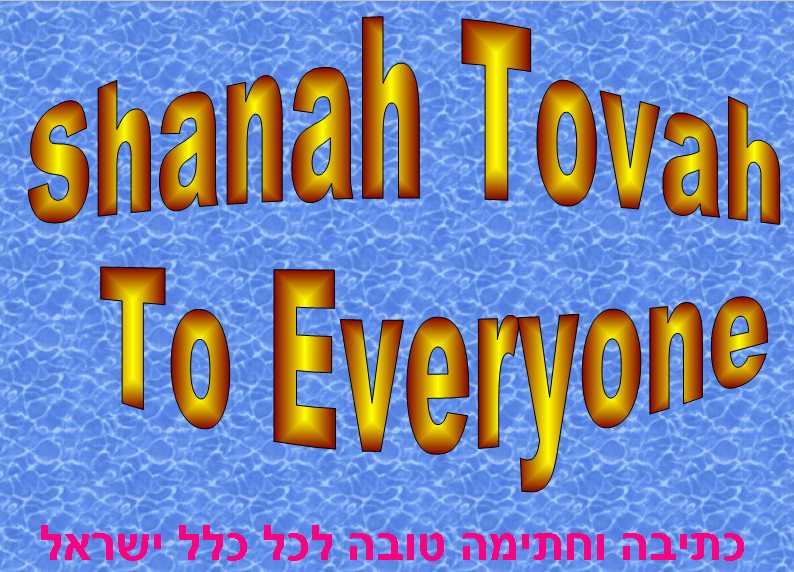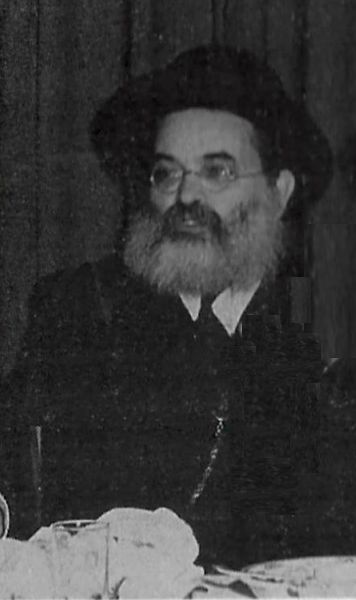  |
|
| |||||||
The next scheduled issue is for Sukkos. 
This Google Custom Search looks only in this website. Emunas Chachomim is the Foundation: Remarks of HaRav Shraga Shteinman
"It is a tremendous merit to bring people to Olam Haba, so that they know the purpose for which man was created. It is especially important to hail the Arachim organization which imbues in baalei teshuva the concept of "Emunas Chachomim" — to provide this sector with the requirement of consulting rabbonim and mentors regularly so as to be guided on how to conduct themselves in all of the changing challenges of life. Only thus will their path of avodas Hashem be established on firm foundations which will never weaken."
These were the words of HaRav Shraga Shteinman, Rosh Yeshivas Orchos Torah and member of the Moetzes Gedolei HaTorah, during a preparatory assembly for rabbonim and directors of the Arachim organization which took place in their Bnei Brak headquarters.
Head of the Halachic Division of Institution for Agriculture According to Halocho, and formerly secretary of HaRav Yosef Sholom Eliashiv, zt"l.
Note that this article was originally published in 1994/5754, 4 shemittas ago.
It is reasonable to assume that many readers will be finished with this article after no more than glancing at its headline. The widespread feeling is that everything is already known about Shmittah in general and in particular about otzros beis din—everything is simple and obvious to all.
In fact, just the opposite is true. Just now, the shelichei beis din of HaRav Nissim Karelitz, av beis din of Bnei Brak and rosh kollel Chazon Ish, have begun the harvest in the vineyards in order to produce wine and grape juice that will have kedushas shevi'is. This development would prompt us to review what we know about otzar beis din even if all of its halachos were well-known; such study is still more imperative since several details have not been sufficiently clarified.
I do not intend to delve into the halachic aspect of how an otzar beis din functions in itself, but rather to outline our twofold obligation on the sidelines:
First of all our responsibility as consumers to strengthen the observance of Shmittah in Eretz Yisroel, and second our commitment towards the heroic farmers who observe Shmittah and distribute their agricultural produce through the otzros beis din strictly according to halocho.
The massive historic rally gathered together an assemblage of some one hundred thousand women and girls from the higher grades of seminaries throughout the country under the watchword of "Toras Imecha - the Teachings of the Mother" which took place this past Monday evening. It encompassed messages from our Torah leaders, headed by the Rosh Yeshiva, HaRav Gershon Edelstein, which were relayed live from a special gathering especially organized from his home.
It was headed as well by HaRav Dov Lando, HaRav Moshe Hillel Hirsch, HaRav Dovid Cohen and the Admorim of Vishnitz and Modzitz. HaRav Masoud Ben Shimon related the blessings of HaRav Shimon Baadani. All of these gedolim delivered heartfelt addresses calling for fortification of the Jewish home and embracing paths of salvation and refuge from the ravages of modern technology coupled by a call to purify the camp and strengthen it with the advent of the upcoming Yomim Noraim.
Tens of thousands of women rallied to the call of gedolei Yisroel from all the communities and camps which urged Jewish women to consolidate at a historic rally which would be a turning point in strengthening all Jewish homes in vigil against all harmful influences. The Rosh Yeshiva's cry to Jewish women was "so that the more participants to this rally, the greater will be its impact on the public as a whole."
"To strengthen the Palestinian Authority." This is the message issuing from the top government officials beginning with Prime Minister Lapid, via Security Minister Gantz and on to additional present government members. To strengthen the [Palestinian] security staff and personnel including Abu Maazen and the entire body of those criminals, because the alternative of Hamas and the Islamic Jihad is apparently worse.
But just a reminder: this selfsame P.A. continues to pay monthly salaries to murderers of Jews. The Lavi organization which is involved in proper administration reveals data about the actual scope of this support of murderers.
A Palestinian who hurt a Jew and was sentenced to two years, will nonetheless receive 1,400 shekel a month. One who succeeded in killing and was sentenced to 30 years, will receive a monthly stipend of 12,000 shekel. There is an explicit price for Jewish blood. More blood is worth more money. And everything is anchored in the laws of the Palestinian Authority.
In preparing for the tenth yahrtzeit of HaRav Kamenetsky, zt'l, we came across this important essay on learning Nach. It seemed that the month of Elul is a very appropriate time to learn the lessons given here. This essay was first published by us in 1996/5756.
Part I
For Part II of this series click here.
From Sinai
There is a measure of difficulty involved in the teaching of Nach and consequently, a measure of inaccuracy. However, before addressing these issues, I would like to dwell on the essential character of Nevi'im and Kesuvim.
An astonishing piece of gemora at the beginning of Brochos (5) explains the posuk, (Shemos 24:) "And Hashem said to Moshe, `Ascend to Me, to the mountain and I will give you the tablets of stone and the Torah and the mitzva which I have written for teaching'."
The gemora explains, " `the tablets of stone' — these are the Ten Commandments, `and the Torah' — this is scripture, `and the mitzva' — this is mishna, `which I have written' — these are Nevi'im and Kesuvim, `for teaching' — this is Talmud. This teaches us that all of these were given to Moshe on Har Sinai."
One item on this list seems to be incomprehensible.
* * *
Outstanding Articles From Our Archives
Opinion & Comment
by Rabbi Mordecai Plaut, based on a shiur of a rosh yeshiva in Yerushalayim
(HaRav Moshe Shapiro zt"l)
Part IV
Part I discussed the fact that the seven haftarahs that we read from Tisha B'Av until Rosh Hashonoh show that consolation provides a crucial bridge that takes us from the Churban to the Tikkun that we have on Yom Kippur, equivalent to our receiving the Second Luchos on that day. However, we do not even understand what consolation is and how it could be possible. How can we console someone in the midst of a loss? Consolation does not mean distraction, so how is such a thing possible?
A Yom Kippur of HaRav Chaim Soloveitchik of Brisk
As heard by HaRav Yitzchok Zeev Diskin zt'l from Maran HaRav Yitzchok Zeev Soloveitchik zt'l, the Griz, who was involved in the story.
The Griz once told his talmidim that they cannot know what the true desire of Heaven is. In this story, we see gedolei olom who spent much of the Yomim Noraim one year in strenuous efforts to save two simple Jews. For the most part, the circumstances were clear and the halochoh was clear. They acted as they did, without hesitation, according to the principles of Torah. The unfolding tale also illustrates how, sometimes, hishtadlus is one thing and success is another. Hashgochoh makes things happen in ways that are unanticipated, if we only do as we must.
Background
This happened between 5666-5668 (1905-1908), years of popular unrest and discontent against the inept and autocratic Czarist rule over Russia. After the revolutionary movement's first attempt in 1905, the Czar Nicholas II signed the October Manifesto forming the Duma, Russia's parliament, which was to have power to confirm all legislation. This institution would have turned the Russian government into a constitutional monarchy.
The Czar patronized an extremist right-wing organization, the Union of the Russian People, which sanctioned terrorist methods and disseminated antisemitic propaganda. As a result, pogroms against Jews swept over the entire country, beginning in Kishinev and lasting for several years.
Never Remove Your Love from Us!
by A. Gefen
Oozing Wounds
Yeshivas Chevron, on the first night of Rosh Hashonoh 5690 [92 years ago, just over a month after the great pogrom in Chevron].
The atmosphere is serious and solemn, as befits this night. Yet here, it is oppressively so. The cause of the extra tension is not the Rosh Hashonoh that is about to be ushered in but the thought of the preceding one. That was when the dreadful, awesome decree was propounded, whose execution ten months later left all those presently filling the hall of the Beis Hava'ad Hakeloli as survivors.
They are suspended between heaven and earth, between hope and despair. Those who are not smarting from their own wounds, are smarting from the wounds of their friends. Feeling like broken shards and shadows of their former selves, they have gathered to celebrate the first night of the festival of Rosh Hashonoh. However, the hush that precedes the beginning of ma'ariv only serves to compound their uneasiness and their confused feelings.
During the `days of awe' that they all experienced forty days ago, during the pogrom in Chevron on the eighteenth of Av 5689, virtually all of them suffered the loss of some part of themselves. Over here sits someone who lost his earlobe; over there sits another, who was torn apart by the sight of the slaughtered martyrs in their death throes. Here is someone who lost his left hand; there is someone else, who lost a friend who was as close to him as his right hand.
Ma'ariv is due to begin in just a few minutes. Everybody waits. Here, a bochur tries to look into his machzor; there, another attempts to bury himself between the pages of a gemora.
There is no humming in the air, no excited anticipation of the onset of the Yom Tov. The atmosphere is so very serious and so sad that it seems just too heavy to be lifted. The congregation sit like mourners, their eyes lowered. The silence is only punctuated by occasional groans from this or that corner of the room. Their hearts swell. `Yom Tov is almost upon us but what is to become of us? Where is our comfort, our reassurance?'
The Thoughts of our Heart
by Mordecai Plaut
"And for the sin that we committed before You in our heart's thoughts" (behirhur haleiv).
One of the sins for which we beat our breasts on Yom Kippur is for having the wrong thoughts. If the wrong thoughts flit through our minds, we ask forgiveness from Hashem. We want our minds to be places whose contents are pure and holy all the time: 24/7.
There is plenty to think about. There is a huge Torah, longer than the earth and wider than the sea, as rich and varied as the entire human experience. There are things we could have done better and good things to plan for the future.
There is no need to think negative thoughts about others or about ourselves. Thinking about bad things, contemplating doing forbidden actions, even just observing morally ugly things -- are all wrong and damaging, sometimes leaving permanent scars.
Today it is often hard to appreciate how profoundly bad and damaging even a passing thought can be.
|
|||||||




.jpg)





